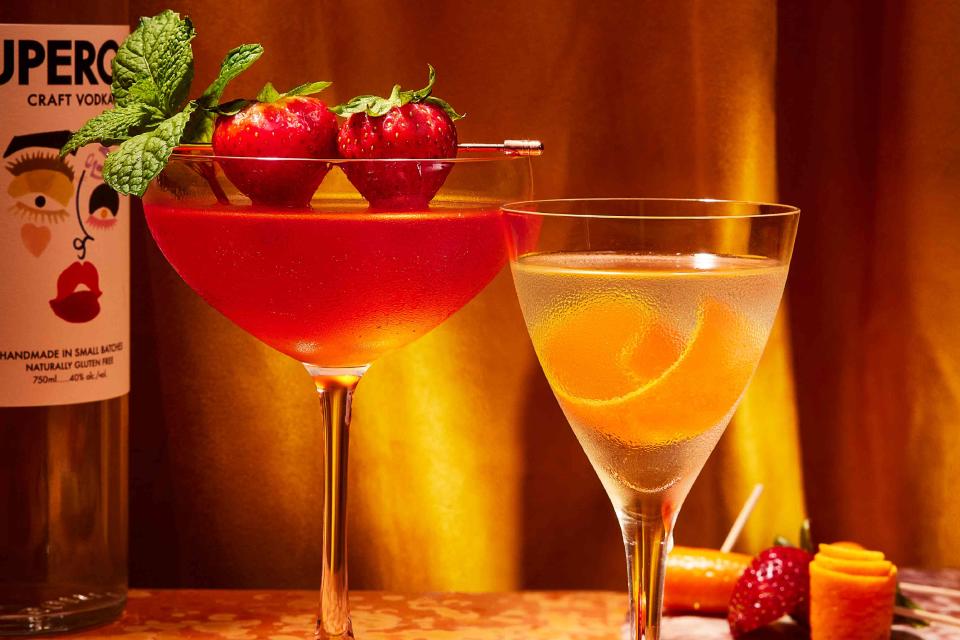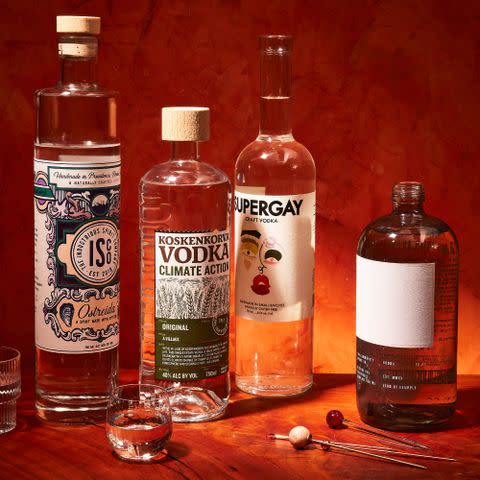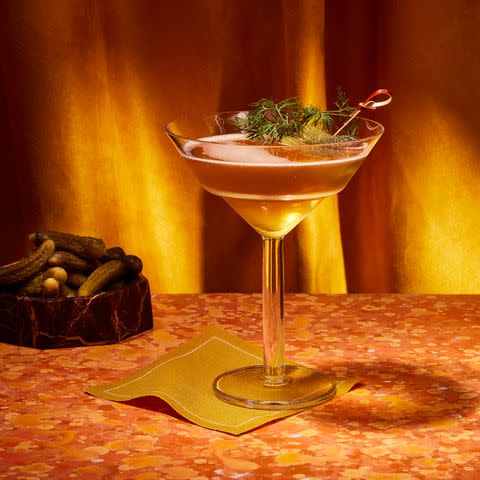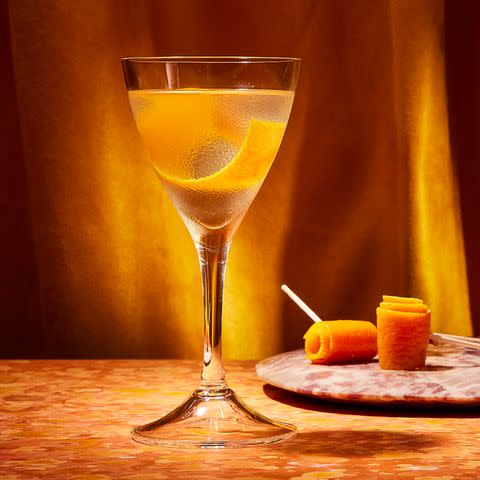Why We're Falling (Back) in Love With Vodka
Once the bane of bartenders, ambitious craft versions have changed this go-to spirit’s reputation.

Jennifer Causey / Food Styling by Margaret Monroe Dickey / Prop Styling by Claire Spollen
At The Betty supper club in Atlanta, beverage director Darius Naderi infuses Aperol with seasonal strawberries, then swaps it for the cranberry juice in a crafty comeback of the Cosmopolitan. The result is the Retropolitan, an adult-style Kool-Aid: dangerously gulpable, yet sophisticated enough for thoughtful sipping. What adds the layers of salty earth and vanilla beneath the bitters and berries? The answer, believe it or not, is the vodka.
Naderi uses Pennsylvania-based Boyd & Blair vodka, made with local potatoes fermented with Champagne yeast to draw out their rich, silky sweetness. It’s one in a rising wave of vodkas upending the spirit’s wallflower image. “In the 1980s and ’90s, I thought of vodka as the tofu of spirits,” says Naderi. “But newer vodkas come with nuance and depth.” (To be fair, tofu does, too.)
Once defined by the Alcohol and Tobacco Tax and Trade Bureau as “without distinctive character, aroma, taste, or color,” vodka has so diversified that, in 2020, the TTB scrubbed that phrasing. “It’s no longer just Popov and Smirnoff,” says Tony Abou-Ganim, author of Vodka Distilled: The Modern Mixologist on Vodka and Vodka Cocktails.
Nowadays, vodkas come from all over the world and are distilled from novel ingredients: Japan’s clean, rice-based Haku; South Africa’s approachable Vusa, distilled from sugar-cane; fruity St. George, made with California pears; Kástra Elión, a Greek vodka derived from olives that’s a knockout in a briny martini. Low-ABV vodkas like the smooth, 55-proof Sommarøy temper intoxication. Organic vodkas, such as Purity, use earth-friendly grains. There are even vodkas with a mission, fighting climate change and boosting social causes.

Jennifer Causey / Food Styling by Margaret Monroe Dickey / Prop Styling by Claire Spollen
Established producers have diversified, too. To its popular potato-based flagship, Chopin has added a wheat vodka and a rye vodka, the latter now a standard on the martini carts that so many upscale restaurants have been rolling out. Says Aviram Turgeman, beverage director at Manhattan’s Monterey, “I love playing with its spiciness.” He adds a dash of orange bitters and an orange twist for “citric lift.” The brand has even rolled out a higher-proof version of the rye vodka, called Bartender’s Choice. More potent by half at 60% alcohol, it’s made for blending into multi-ingredient mixed drinks.
With the revival of the vodka martini, “people are celebrating local distilleries making great spirits,” says Abou-Ganim. At Oregon’s “farm-to-flask” Thinking Tree Spirits, the Main Stage vodka is made from Cascades water and non-GMO white wheat sourced from neighboring growers. It’s distilled 21 times, but that doesn’t mean it’s bland. “It’s so smooth and creamy, you don’t need to hide it,” says the distillery’s tasting room manager David Heter, who uses its lemon-blossom tones to brighten a spicy, pickly martini called The Lovesick Crocodile. Locavorism is elevating flavored vodkas, too. Thinking Tree’s standout for a spritz is infused with organic lavender and given its purple hue with butterfly pea flower.
Related: Flavored Vodka Isn't Just for College Kids Anymore
“After decades of intentionally flavorless plain vodka or overly artificially flavored vodka, people now want vodka that offers notes that nod to the origin of the spirit and that can be complemented with cocktail ingredients rather than overpowered by them,” says Thinking Tree’s Darcey Howard.
We are also finally catching up with the vodka styles that are appreciated in the spirit’s countries of origin. “In the West, we’ve looked for a neutral product,” says Abou-Ganim. “But when you talk about Poland and Russia, it’s a big, robust style.” Distilled only once from estate-grown potatoes, Colorado’s Woody Creek Distillers offers what he calls an alluring “funk” in their vodka — a “musty, vegetal, mushroomy, potato-skin” flavor that makes it “the main player” in his Rocky Mountain Wizard.
With white vermouth and yellow Chartreuse “complementing and celebrating the vodka,” it’s a martini with an herbaceous, earthy punch. But Abou-Ganim’s favorite way to enjoy this rootsy vodka is even more Old World: poured from the bottle, “right out of the freezer, alongside a dollop of osetra caviar.”
The Retropolitan

Jennifer Causey / Food Styling by Margaret Monroe Dickey / Prop Styling by Claire Spollen
This riff on a Cosmopolitan cocktail calls for strawberry-infused Aperol instead of the usual cranberry juice. The infused Aperol provides a sweet, tangy, fruity kick to this punchlike drink. It’s also delicious in a spritz, and the leftover liqueur-soaked straw- berries are perfect for spooning over sorbet or ice cream.
The Lovesick Crocodile

Jennifer Causey / Food Styling by Margaret Monroe Dickey / Prop Styling by Claire Spollen
This surprisingly invigorating, bracing libation relies on Ancho Reyes, a Mexican chile liqueur made from smoky, sun-dried ancho chiles. The readily available liqueur imparts earthy and sweet aromas of dark chocolate and coffee and an assertive heat to the cocktail. The pickle juice acts just like a touch of salt, seasoning the drink and elevating and enhancing its robust flavors.
Rocky Mountain Wizard

Jennifer Causey / Food Styling by Margaret Monroe Dickey / Prop Styling by Claire Spollen
Only 3% of vodkas worldwide are made from potatoes, due to their finicky fermentation process. Las Vegas mixologist Tony Abou-Ganim uses the more earthy, nutty notes in Woody Creek’s vodka to pair with the mellow, honeylike sweetness of yellow Chartreuse. While potato vodkas are not as common as rye vodkas, they can easily be found at most liquor stores.
For more Food & Wine news, make sure to sign up for our newsletter!
Read the original article on Food & Wine.

